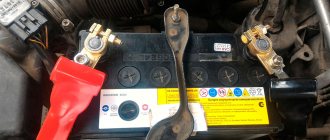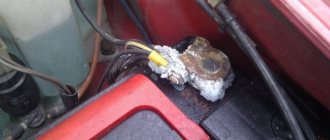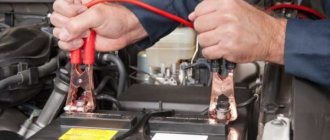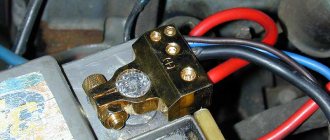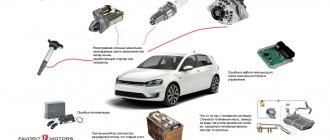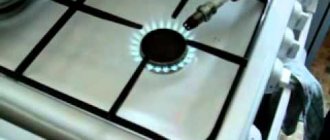It is a mistake to think that the battery in a car is needed to turn on music when the engine is not running and the generator does not supply power to consumers.
The battery's job is to start the power unit. Some people don't see anything difficult about it. And you ask your father or grandfather what it was like to manually turn the crankshaft using a crooked key to start the engine. This is the function that the battery actually performs.
It is difficult to overestimate the importance of the battery. Therefore, increased demands are placed on its selection, operation and maintenance. Sometimes it happens that traces of oxidation processes appear on the terminals. Some people don’t attach any importance to this, while others try to quickly find and eliminate the cause.
Reasons for terminal oxidation on a car
Corrosion of the terminals leads to poor contact with the vehicle's electrical system. The consequence is a decrease in starting current, which makes starting the motor difficult, especially in winter.
The generator is less efficient at recharging the battery. This happens because the oxide layer acts as a resistance, preventing the normal passage of current.
In this case, the contacts become very hot, especially when the starter is turned on.
There are two reasons for corrosion on terminals:
- Poor contact. Due to loose contact, sparking and heating of the leads occurs, this contributes to an increase in the intensity of natural corrosion of the metal, on which a dense, although thin, layer of metal oxide appears. It may have a blue or green tint.
- Contact of metal with electrolyte. Acid evaporates from the battery cans when charging it, settling on the case. It gradually corrodes both the lead terminals of the batteries and the copper terminals of the cables. Chemical oxidation is easily determined by its appearance - the oxide layer is loose, thick, light in color, usually a little bluish.
Often, due to weak tightening or loosening during operation, the terminal begins to become covered with a corrosive layer.
The contact points begin to overheat, sparks jump out, leading to burnout of the metal.
The longer this position is maintained, the denser the oxide layer. It indicates that the driver does not take care of his car.
The formation of a loose mass of oxides indicates the possibility of damage to the housing. It is also possible that the voltage coming from the generator is too high, causing the electrolyte to boil, settling in vapor on the top cover.
Oxidation of contacts due to electrolyte entering the terminals.
Here is a list of reasons for significant terminal oxidation:
- Intensive evaporation of electrolyte. When boiling, the liquid evaporates from the cans, exiting through the ventilation holes, then settling on the battery cover and terminals.
- Cracked body. A crack or chip in the top cover leads to increased evaporation or splashing of electrolyte, which ends up on the terminals.
- Undercharging. For this reason, the current output and capacity of the battery decreases. The voltage decreases, but the current increases, which increases the load on the battery. This leads to heating of the connections and acceleration of electrochemical corrosion.
- Recharge. Too much voltage applied to the battery leads to boiling of the electrolyte and increased evaporation. More electrolyte is deposited on the terminals, quickly corroding the surface layer of metals.
- Leakage current. Current leaks can occur due to a dirty housing or a wire with frayed insulation that is shorting. Due to current leakage, its consumption increases, the battery terminals heat up, oxidizing under the influence of electrochemical corrosion.
- A closed bank. If there is a short circuit in one of the battery cans, it is excluded from operation. The voltage of each bank is 2 V. Since they are connected in series, the total voltage is 12 V. Without one bank it drops to 10 V. Because of this, the normal voltage generated by the generator becomes excessive for the battery, leading to overcharging.
Often, by the type of oxides, the contact at which they appeared and the intensity of their accumulation, one can roughly name the cause of their occurrence.
So, when electrolyte gets on the terminals, the coating turns out loose, like snow. Loose contact leads to the appearance of spark craters, dark spots and dense deposits.
Corrosion usually affects both terminals of the battery, but sometimes the coating is visible only on the positive or negative electrode.
Why does the positive terminal on the battery oxidize?
On modern cars, the “+” terminal of the battery is covered with a red protective cover.
Oxidized positive terminal on the battery.
It protects the output from accidental short circuit, reduces the impact of moisture and evaporating electrolyte on the metal. However, if you do not lift the lid, existing problems will not be visible.
If the positive terminal is oxidized, but the negative terminal is not, then the most likely reasons may be:
- increased voltage coming from the generator due to a faulty relay regulator;
- short circuit of one of the cans, due to which overcharging occurs when normal voltage is applied;
- a crack in the case or a boiling jar near the terminal, due to which the electrolyte gets only onto the positive terminal.
Why does the negative terminal of the battery oxidize?
The current flows from minus to plus. This feature leads to the fact that in the case of a weak contact, the negative terminal heats up the most.
This also happens if the power cable on the car is too thin.
Oxidized negative terminal.
The “–” terminal is oxidized alone or has a more pronounced layer of corrosion in the following cases:
- poor contact at the terminal;
- the negative cable has weak contact with ground;
- power cables have insufficient cross-section;
- The battery is systematically undercharged.
If both terminals are equally covered with loose deposits, then electrolyte has reached them.
Look for cracks in the body, also check the electrolyte level; perhaps it is boiling in all the jars, or it is not evaporating well due to clogged ventilation holes in the plugs.
With fine and dense oxidation, the wine lies on weak contact.
Is it possible to clean the terminals mechanically, for example using sandpaper?
If you act without fanaticism, such processing is permitted. Moreover, many manufacturers recommend cleaning the contacts with fine-grit sandpaper before applying the protective compound.
This ensures that oxides are removed and the surface is cleaned of dirt. Previously, special “brushes” with metal bristles (external or internal type) were used for processing.
Driver mistakes that lead to terminal oxidation
If the electrical system is in good working order and the terminals are tightly clamped, the battery terminals should not corrode.
The presence of oxides indicates a problem that needs to be corrected or violations of the battery operating rules.
For example, cracking of the housing near the terminals occurs due to attempts to over-tighten the contacts or attempts to remove the terminal without first loosening it.
Also, the housing can crack from vibration while driving if the battery is not seated correctly in its socket or is not secured tightly and hits the body of the engine compartment.
All the main driver mistakes that lead to oxidation of contacts on batteries are presented in the following table:
| Description of the error | What is observed | What to do |
| Power cables are of insufficient cross-section | There is a dense, thin coating on the terminals. When the starter is turned on, the cables heat up, which can be felt by hand. | Install multi-core copper cables with a thickness of 16 square meters. mm or more, tighten them tightly at the joints. |
| A drop in the electrolyte level, a change in its density to unacceptable values | The oxides are loose and snow-like. They arise due to intensely boiling electrolyte. The battery discharges quickly and the starter has difficulty pulling. | Check the voltage on the battery when idle and with the engine running. Check the level and density of the electrolyte regularly every 10 thousand km. |
| Excessive number of additional electrical appliances (radio tape recorder, speakers, alarm, additional headlights, etc.) | Dense layer of oxides. The cables get hot. When the engine is turned off, the battery voltage is 12.6 V, which indicates insufficient charge. | Replace the power wires with thicker ones (for every 8 A of current there should be an additional 1 sq. mm of cross-section). The battery should not be either undercharged or overcharged. If the power of the generator is no longer enough to properly power the electrical system, then you need to install a more powerful model. |
| The terminals are not properly tightened and the battery is not secured in place. | The starter does not work well, clicks may be heard and sparks may appear at the battery terminals. The oxides are dense, there are traces of burning. The terminals are loose on the terminals. | Tighten the terminals firmly, but not excessively, after cleaning the terminals and terminals with fine sandpaper. Tighten the bar securing the battery to the seat. |
| Electrolyte enters the case through cracks, chips, ventilation ducts | There are loose oxides. Traces of electrolyte or greasy dirt are visible on the housing cover. If there is a significant amount of electrolyte, nearby metal parts may be damaged. | Check the housing for damage. Check battery voltage, electrolyte level and density. Wash the battery case with a weak soda solution. |
| Battery is undercharging or overcharging | Corrosion on the negative terminal due to undercharging. When overcharging, the positive contact oxidizes. | Check the voltage on the battery and generator, tighten the connections. |
What to do if the battery terminals are oxidized
Wipe the terminals and contact pins with a soda solution, and clean with fine sandpaper.
After tightening, it is advisable to protect the terminals with a special lubricant to protect the contacts from oxidation.
5 Best Battery Terminal Lubricants
Attention! Lubricant is applied after the contacts are tightened. It should not be on contacting surfaces!
Lubricant to protect the terminals on the battery.
The lubricant creates a protective layer, protecting the terminals from contact with electrolyte and water.
Clean the body from dirt and wash it with a 10% soda solution. Use regular baking soda. Then wipe the body dry with a clean rag.
Washers to prevent electrolyte from getting onto the contacts.
If there are microcracks near the terminals, use washers cut from rags to cover the housing. The washers need to be soaked in lithol or machine oil.
Large cracks can be repaired with a soldering iron by passing the flat side of the heated tip over them. Do not use sealants - they do not adhere well to the plastic case and are afraid of acid.
How to apply lubricant, and where is it best to apply it?
To extend the life of the lubricant and protect the terminals from oxides, it is important to strictly follow the technology for applying protective compounds.
Here the algorithm of actions is as follows:
- Cleaning the surface of the terminal and nearby areas from contamination. This is required to reduce resistance to a minimum.
- Cleaning the terminals and putting them on the battery. Next, it remains to tighten the nut for maximum fixation.
- Treatment of the top and side of the tip and outlet. It is important not to miss anything here to avoid moisture getting on the surface.
Please note that it is recommended to process the entire node, and not just some specific elements.
It is worth remembering that lubricating the inside of the terminal before applying it to the battery is prohibited. Otherwise, it will not be possible to achieve high-quality contact, and the treatment itself will only cause harm.
FAQ
What is the cause of oxidation of battery terminals?
First of all, this is a weak contact at the battery terminals or electrolyte entering the contacts from the ventilation ducts of the cans or through cracks in the case.
What are the dangers of oxidation of battery terminals?
Oxides do not pass current well, causing wires and contacts to heat up, the battery does not charge well, and the starter has difficulty cranking.
How to prevent oxidation of battery terminals?
Check the battery and contacts periodically. The body must be washed with a soda solution, the terminals must be tightened well, but not excessively, and then covered with a layer of special dielectric grease to protect them.
After cleaning, the battery terminals still oxidize heavily, what should I do?
This means that the cause of the corrosion was not found and corrected. Inspect the battery again, check the connections at the battery terminals, the reliability of the connection of the negative cable to ground, check for undercharging or overcharging.
Identifying the problem
Oxidation of battery contacts can be determined by a number of signs. These include the following:
- The starter does not engage immediately or it is very difficult to turn the crankshaft. The most important thing is to start repairing it right away, otherwise the car's electrical system may fail.
- Dimming of side lights and headlights can also be a result of oxidation of the battery terminals.
When thinking about what to do if the battery terminals are oxidizing, you need to remember that you need to solve the problem as soon as possible. If you neglect this, the car’s battery will become unusable, and you will have to spend money on a new device.
